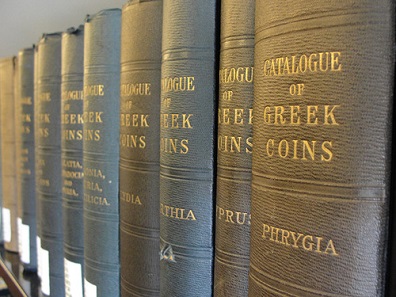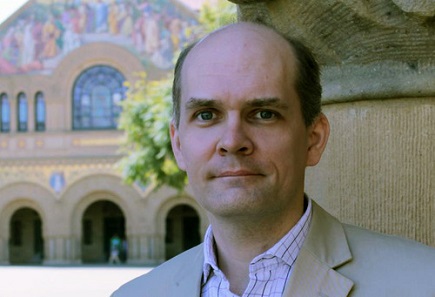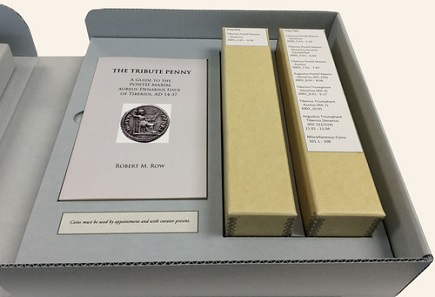by David A. Jordan
Stanford University Libraries
courtesy of Stanford University Libraries
August 4, 2016 – The Frank L. Kovacs Numismatic Library, undoubtedly one of the largest and most complete reference collections on ancient numismatics situated on the West coast of the U.S., is now housed at the Stanford Libraries and was immediately put to use by students and a visiting professor throughout spring-quarter seminars.
An important reference library and treasured Bay Area resource was at risk of being dismantled until six local numismatists offered to purchase the entire collection for Stanford in support of on-going research on ancient economies and coinage.
The Frank L. Kovacs Numismatic Library comprises more than 2,700 catalog records.
Comprising more than 2,700 catalog records and occupying 325 linear feet of shelving in the Raubitschek Room in Cecil H. Green Library, the collection has been named the Frank L. Kovacs Numismatic Library.
“This finally puts the Raubitschek Room in the position to provide coverage of all three major types of primary documentary evidence – coins, inscriptions, and papyri – for the ancient world,” said Walter Scheidel, the Dickason Professor in the Humanities.
The library is undoubtedly one of the largest and most complete reference collections on ancient numismatics situated on the West coast of the U.S.
According to Scheidel, who was Chair of Classics at the time of the acquisition, “Access to this collection is invaluable in establishing the study of ancient numismatics as a critical component of our Classics program.”
Right Place, Right Time
The benefactors who in March 2015 philanthropically preserved the integrity of the collection and made it available for scholarly use included Frank Kovacs, a leading Bay Area professional numismatist who assembled and consulted the library throughout his career; his wife Renee Kovacs, a scholar who advises the Cuneiform Digital Library Initiative at UCLA and other institutions; John Jencek, professional numismatist whose office in San Mateo housed the library until his move to Prague, Czech Republic; Mary Lannin, president of the San Francisco Ancient Numismatic Society and chair of the Citizens Coinage Advisory Committee in Washington, D.C.; Richard Beleson, Stanford alumnus and member of the Board of Trustees of the American Numismatic Society; and Lawrence Schwimmer, likewise Stanford alumnus and American Numismatic Society board member.
“The Kovacs Library has dramatically broadened Stanford’s collections,” said University Librarian Michael Keller. “The overlap with the Libraries’ pre-existing holdings was less than 30 percent, making it a highly valued addition.”
Dr. Bernard Woytek.
In merely months after the collection’s arrival, Dr. Bernhard Woytek, head of the division Documenta Antiqua, a research center for numismatics, epigraphy and papyrology at the Institute for the Study of Ancient Culture at the Austrian Academy of Sciences, took up an appointment as visiting associate professor of Classics and offered two numismatic courses.
“In numismatics, as in all other disciplines dealing with documentary sources of the ancient world, like epigraphy and papyrology, it is essential to work hands-on with the primary material,” Dr. Woytek stated. Upon this premise were founded an undergraduate course, Describing and Identifying Ancient Coins, and a graduate proseminar, Ancient Numismatics. Students used volumes from the Kovacs Library alongside coins in Stanford’s collections.
Seminar topics included numismatic terminology; techniques of coin production in antiquity; numismatic methodology (die studies, hoard studies, and metrological analyses); quantifying coin production and ancient financial history; coins versus other forms of money; and the origins of coinage in the ancient world, a guest presentation by Peter van Alfen of the American Numismatic Society, New York.
Peter Shi, a PhD candidate in Ancient History whose research focuses on the living conditions of common residents in different parts of the Roman Empire, found the courses to be “rewarding beyond what the titles promised!”
“Using coins as a nexus, Dr. Woytek explores various aspects of the ancient world and displays the subtle connections between art history, politics, economics, and social history. His class not only introduced basic numismatic skills, but also enlightened me about the usage of numismatic evidence in historical research,” said Shi.
In May, members of the numismatic community, students, faculty, and library donors attended the opening of the Kovacs Library. Dr. Woytek kindly delivered the keynote lecture titled “Numismatics and the Mind of Man: The Study of Ancient Coins from the Renaissance to the 21st Century.”
Dr. Woytek examining a 1567 edition of works by Guillaume Du Choul.
In his introductory remarks at the event, Grant Parker, current Chair of Classics, noted the happy coincidence of Dr. Woytek’s and the late Professor Antony E. Raubitschek’s intellectual backgrounds at the University of Vienna.
“If we are able to conjure up Professor Raubitschek today, he would surely be thrilled that Stanford students have had the chance to study numismatics intensively, to combine practical with more abstract approaches, to put the tiniest details in the big picture of ancient history, to learn at the feet of a master – from the University of Vienna.”
Numismatics at Stanford
The Kovacs Library along with Dr. Woytek’s courses have raised the profile of numismatics as an academic discipline at Stanford University and created new opportunities for interdisciplinary research across all of the humanities and a broad geographical and historical range.
Scheidel is one of several Stanford faculty who have brought to the forefront and challenged conventional notions of how ancient economies functioned.
In addition to ancient coins at the Cantor Arts Center, Stanford Libraries’ Special Collections has a collection of about 175 coins donated by alumnus Robert M. Row and Reverend Dr. Louise M. Row.
Housing of the R. M. Row Collection of Roman Imperial Coins.
The R. M. Row Collection of Roman Imperial Coins was assembled for use during a 30-year study of the popular Roman imperial issue whose denarius is nicknamed The Tribute Penny, because it is thought to have been the coin mentioned in the Bible as the one (possibly) shown to Jesus in the “render unto Caesar…” story.
Other related gifts in kind received after the arrival of the Kovacs Library include an inscribed copy of “The Value of Money” by Dr. Ellen Feingold, curator of the National Numismatic Collection at the Smithsonian; various monographs, journals and catalogs; a numismatic microscope; and a 1567 edition of works by Guillaume Du Choul containing over 600 woodcuts, mainly of Roman coins.
“Numismatics plays a vital role in broader studies of economics and many other interdisciplinary inquiries. We look forward to continuing to build the Kovacs Library for scholarly exploration,” said Keller, who before coming to Stanford in 1993 managed the numismatic collections at Yale Libraries as associate university librarian and director of collection development.
This text appeared first in: “ReMix: The Stanford Libraries Newsletter”, June 2016, Issue 101.









